
|
|
A Unique Rivers Silver Streak Mk. I Those of you who were readers of my regular “Engine of the Month” feature on the late and much missed Ron Chernich’s “Model Engine News” (MEN) web-site may recall an in-depth feature on the subject of the Rivers engines from Feltham in Middlesex, England which appeared in the June 2012 edition of MEN. That article included in-depth coverage of all of the known versions of the Rivers engines in 2.5 cc, 0.19 cuin. and 3.5 cc displacements.
In the event, we saw that while the Mk. I Rivers Silver Streak was an innovative and extremely well-executed design, its performance in standard form did not quite come up to that of the most highly-regarded competition diesels of the day, most notably the Oliver Tiger Mk. III which was the design’s stated performance target. Although the potential was seemingly there, the actual performance achieved in standard form fell a little short of meeting the stated objective. However, subsequent to the publication of my original article, an opportunity unexpectedly presented itself to re-evaluate the full potential of that original Rivers 2.5 cc design. The results of this re-evaluation were sufficiently startling that I felt that an addendum to the original article merited inclusion on my own web-site.
An internal examination of this seemingly well-used but still cosmetically excellent example revealed that it had been subjected to a range of tuning modifications by someone who really knew what he was doing and had access to state-of-the-art grinding equipment which he knew how to use. The bypass passages and transfer ports had been very cleanly and uniformly opened up to logical limits, while the crankweb had been neatly chamfered by grinding to remove a significant portion of the counterbalance - seemingly a somewhat retrograde step in terms of vibration, although it did undoubtedly improve gas access to the two forward bypass passages. A 0.040 in. thick shim had been added to raise the cylinder by that amount, thus increasing both the exhaust and transfer periods. Material had been removed from the piston interior to lighten it. Finally, the central gas passage in the shaft had been opened out to 0.240 in diameter, exactly like the factory-tuned versions.
This opened up the strong possibility that this was one of the very few engines which are known to have been fitted with the patented Rivers combination ball-roller bearing mentioned in my earlier article as being a factory option. The only way to confirm this would be to dismantle the bearing, something which I was not prepared to do given the daunting challenge inherent in its reassembly if my suspicions proved correct! Of course, there was another possibility, which I freely admit that I failed to follow up at the time because it never entered my head - I didn't even check closely! This was the possibility that this example actually was a ball-race engine! I had completely overlooked this possibility until I heard years later from Malcolm Ross (see below), who had some quite persuasive anecdotal information to suggest that this may indeed be a ball-race conversion. Upon re-checking the engine, I found that it did indeed have a rear ball race, completely explaining its very free-running shaft.
The answer became apparent when my good mate Miles Patience acquired the Mk. III Rivers Silver Streak prototype which is illustrated in the late Jim Dunkin's book on the world's 2.5 cc engines. That model too had a rear ball race, and Miles was able to show how it was accomplished. There was no inner race as such - instead, the inner track for the uncaged balls was formed directly in the surface of the shaft! In effect, the shaft became the inner race! Very ingenious, but a daunting manufacturing challenge, requiring precision grinding to an extremely high standard of precision. Miles noted that the omission of the reduced-diameter section of the shaft which normally accommodated the rear needle roller bearing had permitted the use of an internal gas passage having a whopping diameter of 0.285 in. (7.24 mm) - the biggest yet seen in a 2.5 cc Rivers engine. OK, so now comes the hard bit - how to explain the existence of this heavily modified engine? It lacks the usual letter “T” which was added to the serial numbers of customer engines which were supplied by the factory as tuned models to special order. The manufacturers stated very clearly that At first sight, that omission would suggest that this is a very competently home-tuned engine. However, it’s very difficult indeed to envision a private owner having the required combination of technical expertise and precision grinding equipment to carry out the work to the standard displayed in this engine. In particular, how would they open up the shaft port without messing up the shaft heat treatment or leaving any visible trace of their intervention? The porting modifications also reflect a precision machining capability of a standard seldom possessed by any normal aeromodeller. The ball-race conversion too would require a very high level of precision engineering expertise in addition to state-of-the-art grinding equipment. All the circumstances pointed to this being an in-house experimental model produced by Rivers themselves. A further point which supported this hypothesis is the fact noted in my earlier article that Rivers are known to have sent a modified example of the 1960 Mk. II Silver Streak to the Belgian team-race expert Nery Bernhard, hoping that he would elect to use it during the 1961 season. Former Hayes club member Ian Russell (future MERCO owner and instigator of the Rustler series of replicas) examined that particular engine, noting that its crankweb featured an identical modification to that seen in my Mk. I example – most of the counterbalance was neatly ground away. When questioned by Ian regarding the wisdom of this given the implications for increased vibration, Bert Rivers simply replied that the engine had been tested and found to be the most powerful example ever documented by the factory, so what could he do?!? Perhaps the improved gas access to the two forward bypass passages accounted for much of the increased performance?!? In Ian’s well-informed view, such a result could only have been obtained with an extremely heavy and solid bench mounting which absorbed any excess vibration. Ian’s guess was that in a model it would have been a different story. This may well explain Bernhard’s eventual decision not to use the engine in competition. Perhaps he thought that it was a nefarious attempt by “Perfidious Albion” to derail the all-conquering Belgian team!! Regardless, the evidence of the Nery Bernhard Mk. II engine constitutes positive proof that the elimination of much of the counterbalance on the crankweb was recognized by the factory as constituting a legitimate performance-enhancing modification. While it did not confirm the factory origin of my example, this fact is undeniably consistent with the idea that the same modification may have been tried previously by the The proof of the pudding is always in the eating, so a bench test was quickly organized. The engine had clearly done a lot of running, leaving it very free indeed but with slightly less-than-optimal compression. However, there was still plenty of compression for easy starting, while settings were readily established and held. Running qualities were excellent at all speeds tested, with very positive response to the controls and no trace of sagging once set. Vibration levels were noticeable without being excessive, although the fact that the engine was very securely mounted in a fairly hefty test stand might have mitigated this factor by comparison with its behaviour in a model. All this came as little surprise, but the same could not be said of the actual results achieved, which were little short of stunning! The engine proved to have a significantly higher level of measured performance than previously reported or measured for any Rivers 2.5 cc engine, regardless of the model. The following figures and derived performance curve speak for themselves:
The 8½x4 APC prop included in the above set is a trimmed 9x4 which I created specifically to fill a gap in the torque absorption figures for my set of test airscrews. As can be seen, it fills this role perfectly. The indicated peak output of around 0.387 BHP @ 15,300 rpm or thereabouts is a staggering figure which was never to my knowledge even approached by any other British 2.5 cc diesel of the 1959-1960 period. If such figures had been reported by any reputable tester at that time, a new standard for 2.5 cc diesels would have been established overnight. Already I hear a deafening chorus of skeptics claiming that I fudged these results or that there’s something wrong with the calibration of my test prop set! I can only state that these are the same props which I have used for some years now to generate perfectly reasonable and consistent figures for other engines. Besides, even if my calibrations were off, these props would still provide a completely legitimate basis for comparative performance measurement based on prop/rpm figures. I’m happy to replicate these results for anyone who cares to visit - the engine isn’t going anywhere in a hurry! In any case, confirmation that such levels of performance were indeed possible for the Mk. I Rivers subsequently came from no less a source than one-time team race great and 1960 British Nationals winner (using a Rivers) Dave Balch, who is now resident in the USA. When I brought the existence of this engine to Dave’s attention, he immediately recalled an incident dating back to the days when he and Mike Smith were getting their Rivers “works” team really rolling during their ”clean-up” year of 1960 when they won almost everything in sight. Specifically, Dave recalled a 1960 encounter with a team from “up North somewhere” who were also using a tuned Rivers Silver Streak. In Dave’s very clear recollection, the Northerners’ model was at least 10 mph faster than anyone else at the contest, including Dave and Mike with their “works” entry. More to the point, Dave still vividly recalled his utter astonishment at finding that this team (whose names unfortunately he could no longer remember) were using a tuned Mk. I Silver Streak, which simply buried the new factory-tuned Mk. II models which Dave and Mike were using! A 10 mph speed advantage translates into a major horsepower edge, implying that the engine used by these unknown Northerners must have been developing very much the kind of power that is reflected in my figures set out above. Could this be that very engine …..?!? Dave didn't recall ever encountering the mysterious Northerners again, so the question of their identity remained open for some years thereafter.
Happily, Malcolm Ross was able to provide a quite persuasive suggestion. He recalled that in late 1959 or perhaps early 1960 (before he and Derek Heaton got started as a team) he observed the Thornaby team of Bill Haley and Tom Pasco running in a brand new Rivers Silver Streak Mk. 1 and complaining that all the fuel was being pumped out of the front of the shaft - not good for team race fuel economy! Tom Pasco (now deceased) was a brilliant engineer, and Malcolm recalled him stating his intention of modifying this engine by changing the rear roller bearing for a ball-race. He was also talking about sending the modified engine back to the factory for them to take a look at it in addition. Although I can't prove it, the possibility exists that this is that very engine, modified by the factory at Tom's instigation and having a rear ball-race fitted to the shaft in the manner described earlier. Its users were undoubtedly from "up North somewhere" and could well have achieved the kind of speed recalled by Dave Balch using this motor. Bernie Langworth was in agreement with this interpretation of the facts. With that kind of a speed advantage, one is forced to wonder why the very quick Northerners remained unknown in FAI team race circles! Surely they should have cleaned up against all comers?!? However, Dave's recollection of never encountering them again is simply explained by the fact that Healy and Pasco were primarily Class "B" team racers, only competing in the new FAI class for fun on an occasional basis. It's thus entirely possible that the meeting recalled by Dave Balch was their only trip down south to compete in an FAI event using their very rapid Rivers. That said, the record shows that Tom Pasco was a very capable FAI competitor when he did compete. He won the 1958 Scottish Gala in August of that year with a sparkling world-class time of 4:51, obviously not using a Rivers since it didn't exist in 1958. He also placed third at the June 1960 British Nationals behind Nery Bernhard of Belgium and winner Dave Balch, although by then he was using the newly-introduced ETA 15D. Dave seems to have forgotten about this encounter - it was probably Tom's earlier use of that super-fast Rivers that caused him to recall that particular meeting! My friend Andrew Longhurst, from whom I acquired this particular engine, has suggested another very plausible reason for the team's lack of long-term prominence as FAI competitors using their Rivers. Power doesn't come from nowhere - it's generated through the efficient burning of fuel. For an engine of given efficiency, the more power, the more fuel needed. The Rivers was known as being somewhat thirstier than the Oliver and ETA opposition in any case, and a motor tuned to this level of performance would have required even more fuel than a standard unit if its full power potential was to be realized, as it seemingly was if the speeds recalled by Dave Balch are anything to go by. It may well be that the team required at least one, and possibly two, extra pit stops to complete the 100 lap distance. If so, this could have more than wiped out any speed advantage as well as providing additional opportunities for something to go pear-shaped during the pit stops. Andrew has also suggested another possibility. In his own view, the Rivers crankcases were "made of cheese", leaving them ill-adapted to accommodate the installation of a ball-race with its necessary thinning of the case at the front. It's possible that the potential for crankcase failure became apparent before it actually happened, causing Pasco to abandon the effort despite the amazing power output achieved. The record shows that he had switched to an ETA 15D as of June 1960. I may have been a little lucky in that the engine survived my testing! Which brings me to a further muddying of the waters courtesy of my valued mate Ken Croft! After reading my June 2020 Editorial on this matter, Ken was moved to contact both Tom Pasco and his former team race partner Bill Haley. Both were still on deck at the time, although getting up there in years. Interestingly, both of them denied ever having used a Rivers engine at any time! Oh dear...... here we go again!
Accordingly, for now I’m sticking with the very clear and mutually consistent recollections of Malcolm Ross and Dave Balch, both of whom have Tom Pasco down as the responsible party. It seems that the years play tricks with our memories ……… if further enlightenment comes to hand, I’ll be sure to share it. I just want to be fair to all concerned. By way of a bonus, Dave Balch was kind enough to send me a scan of a somewhat faded 1960 newspaper clipping in which the selection of the Smith/Balch team to represent Great Britain at the 1960 World Team Race Championships was announced. The attached image appeared in conjunction with this short article. Apologies for the poor quality of the image, but it’s the only picture of Bert Rivers that anyone has so far been able to provide. Nice to be able to put at least a semblance of a face to the name…….!! Returning to my mega-powerful Mk. I Silver Streak, if it weren’t for that missing T prefix I’d have been certain that this was a factory-tuned “special”. As it is, the standard of workmanship and the equipment required to carry out the modifications to that standard confirms that if this wasn’t modified at the factory, it was reworked by someone having a comparable level of expertise along with comparable access to state-of-the-art precision grinding equipment. There can’t have been too many of those …….. and how did they manage to enlarge that shaft port so neatly?!? There’s no evidence of after-the-fact internal grinding………… To me, it still seems more probable than not that the factory had a close involvement with the creation of this engine. However, the absence of that T prefix suggests that the modified unit was based on an engine which was originally sold as a standard untuned example and modified after the fact. The evidence suggests that this was a My friend and fellow model club member Mel Lyne, an expert combat flier from way back using Rivers power, tells me that when he was growing up in close proximity to the Rivers factory at Feltham, he often used to drop in to the factory after school to hang about and pick up "factory second" components which were always there in boxes for the taking. He recalls that people like Rivers-powered combat ace Baz Bumstead (against whom Mel flew on a number of occasions) were always hanging about the factory getting them to make up modified components for their own Rivers engines. Seemingly Bert Rivers was happy to oblige when the person asking was someone who (like Baz) was adding lustre to the Rivers name through contest success. Mel particularly recalls that Baz's very fast modified Mk. II Rivers Silver Streaks were substantially lighter than the standard versions. How this was achieved is one of those great mysteries!! Quite apart from the story behind its creation, this example bears eloquent testimony to the underlying potential of the basic 1959 Rivers design. It’s now abundantly clear that only the fact that this modified version would doubtless have been far too expensive to manufacture in series prevented the Mk. I Rivers from becoming one of the most remarkable commercial model diesels of its day. ______________________________ Article © Adrian C. Duncan, Coquitlam, British Columbia, Canada First published December 2014 Updated May 2020 (new information on possible former owners) Second update May 2023 (details of rear ball-race installation) |
||
| |
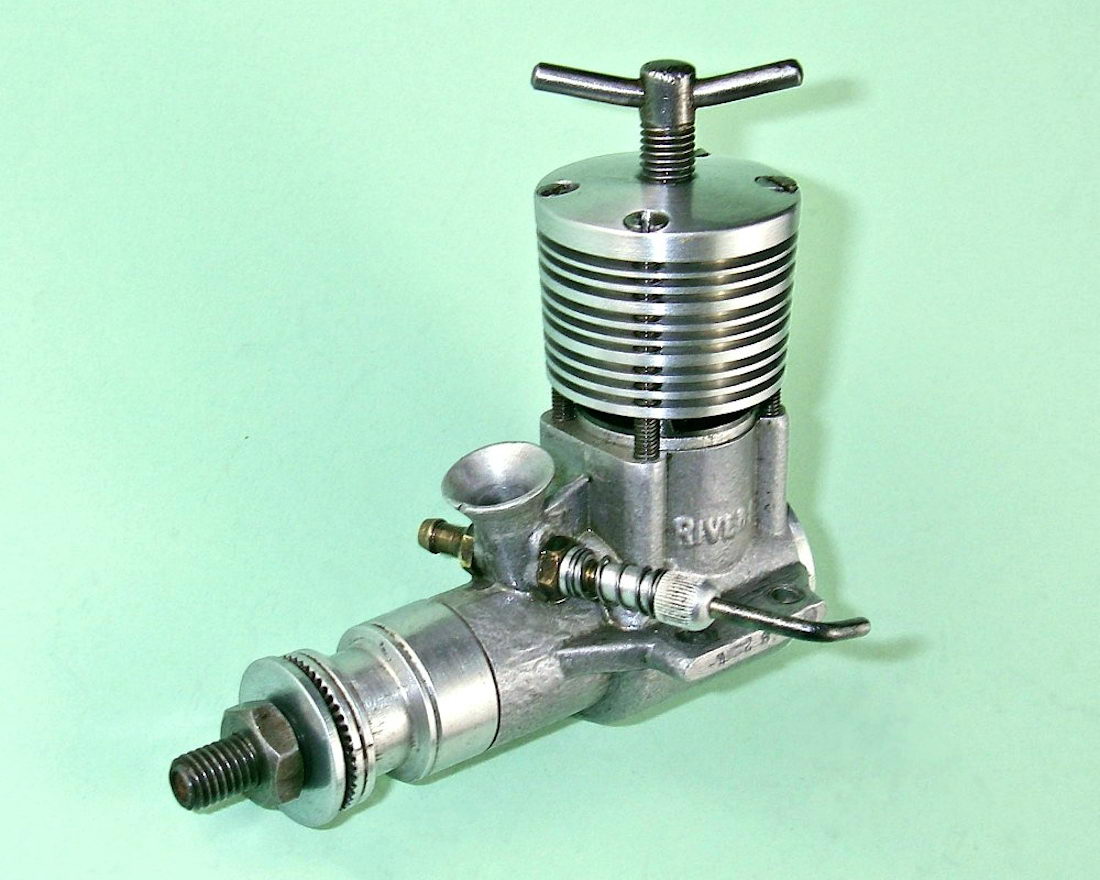 Among these was the Mk. I version of the 2.5 cc Rivers Silver Streak which was released in March 1959, thus becoming the first model engine to be released under the Rivers name. In the earlier article, I noted that the openly-stated objective of company owner and Rivers model engine designer A. E. “Bert” Rivers was to develop an engine that could challenge the might of the established “gold standard” in the 2.5 cc diesel category, the Oliver Tiger Mk. III.
Among these was the Mk. I version of the 2.5 cc Rivers Silver Streak which was released in March 1959, thus becoming the first model engine to be released under the Rivers name. In the earlier article, I noted that the openly-stated objective of company owner and Rivers model engine designer A. E. “Bert” Rivers was to develop an engine that could challenge the might of the established “gold standard” in the 2.5 cc diesel category, the Oliver Tiger Mk. III. 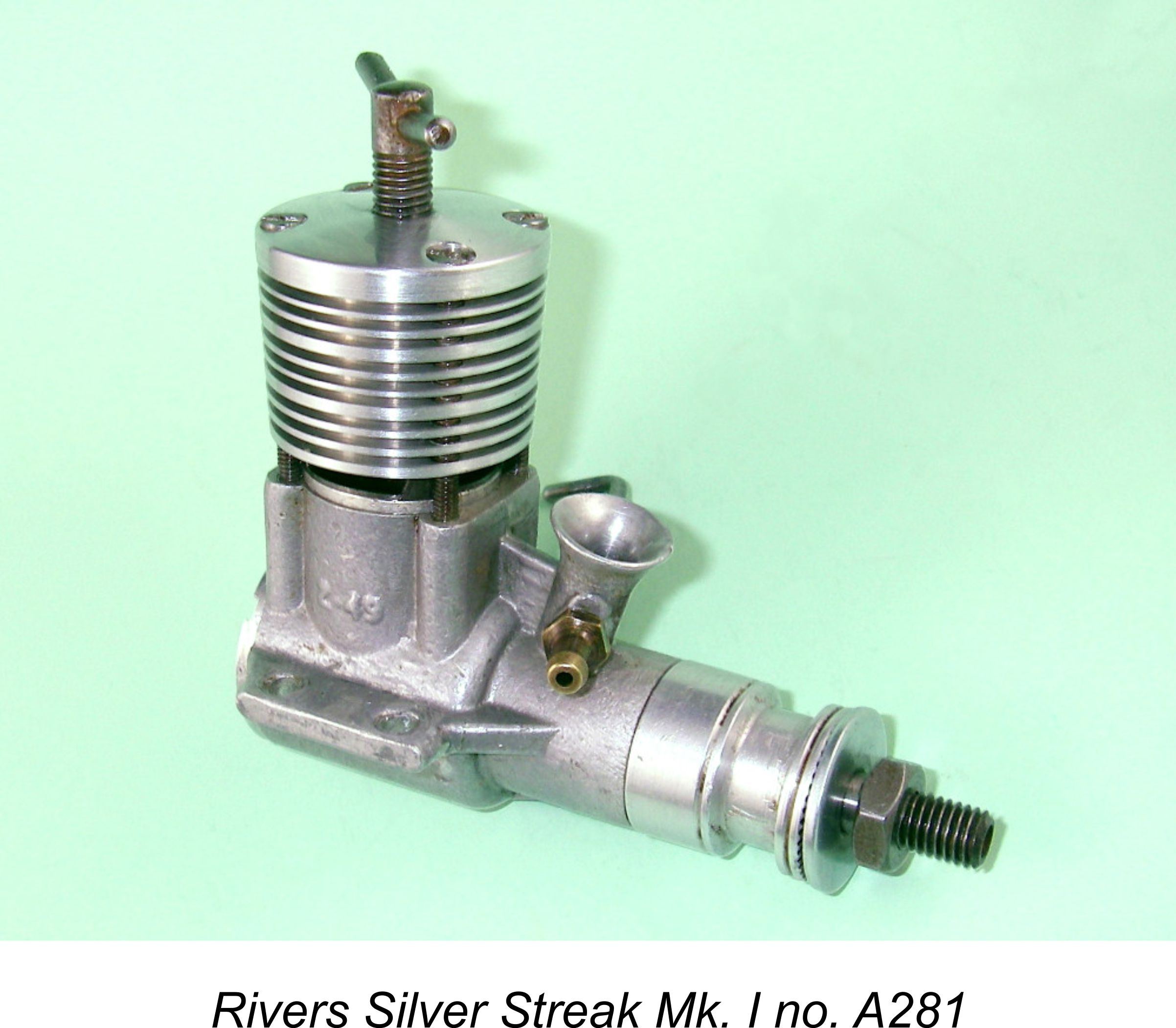
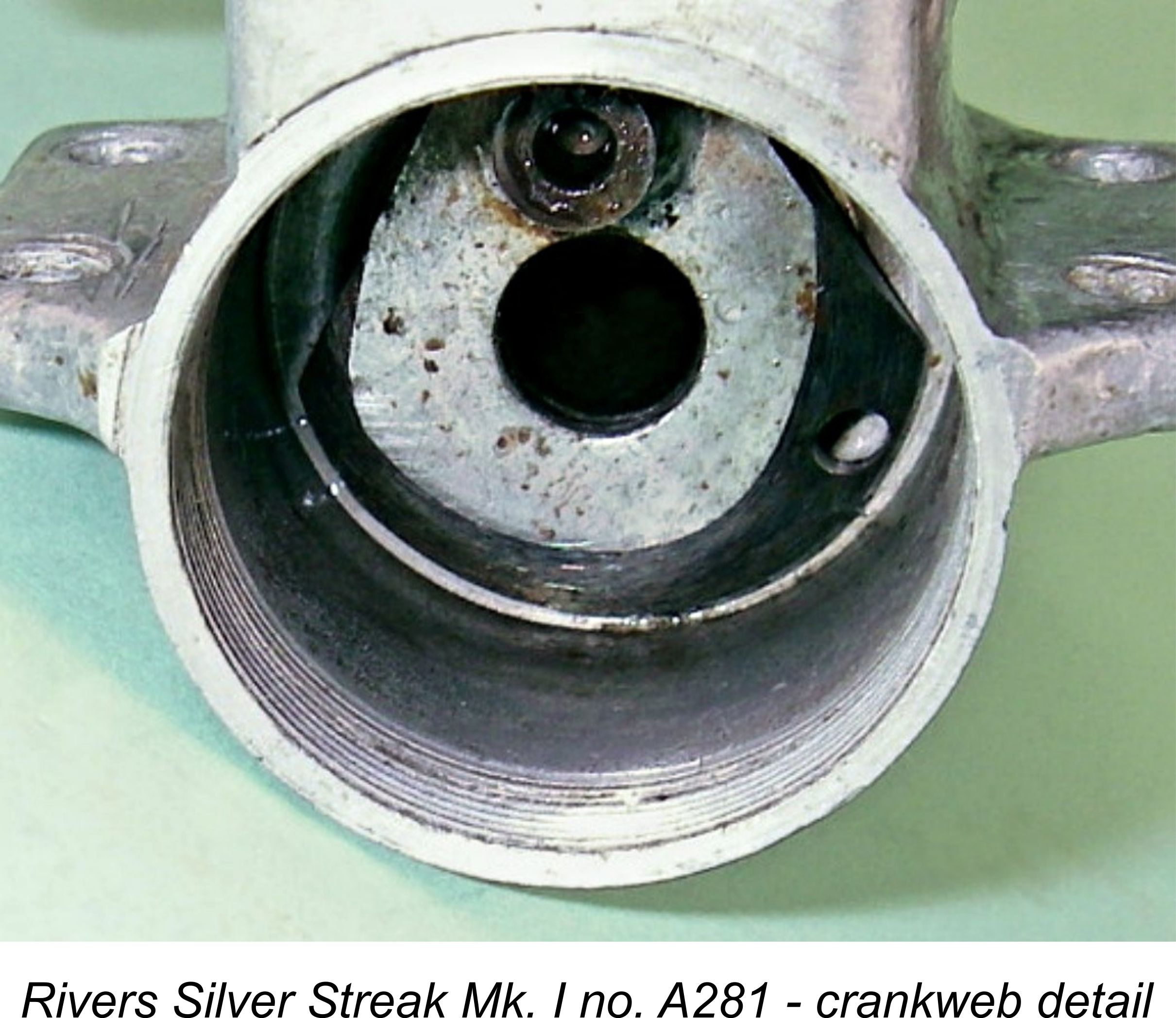
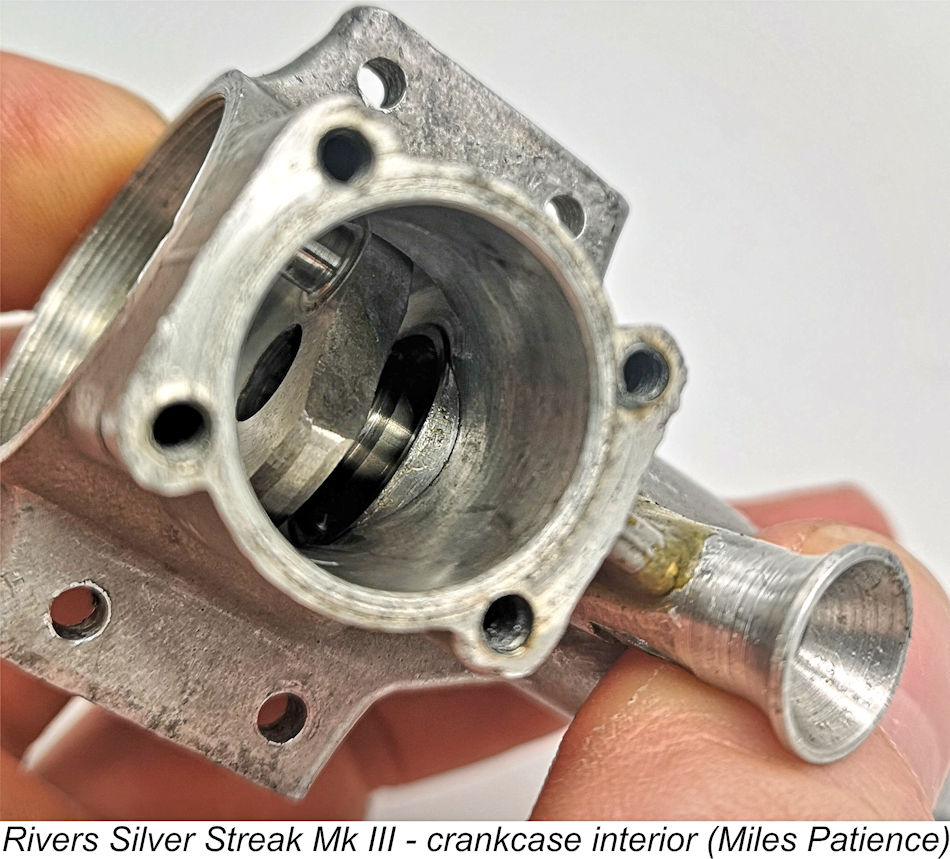 This raised an interesting question - how did the maker fit a rear ball race over the massive Rivers shaft? The external diameter of the outer race looked quite "normal", so how was the inner race accommodated?
This raised an interesting question - how did the maker fit a rear ball race over the massive Rivers shaft? The external diameter of the outer race looked quite "normal", so how was the inner race accommodated? 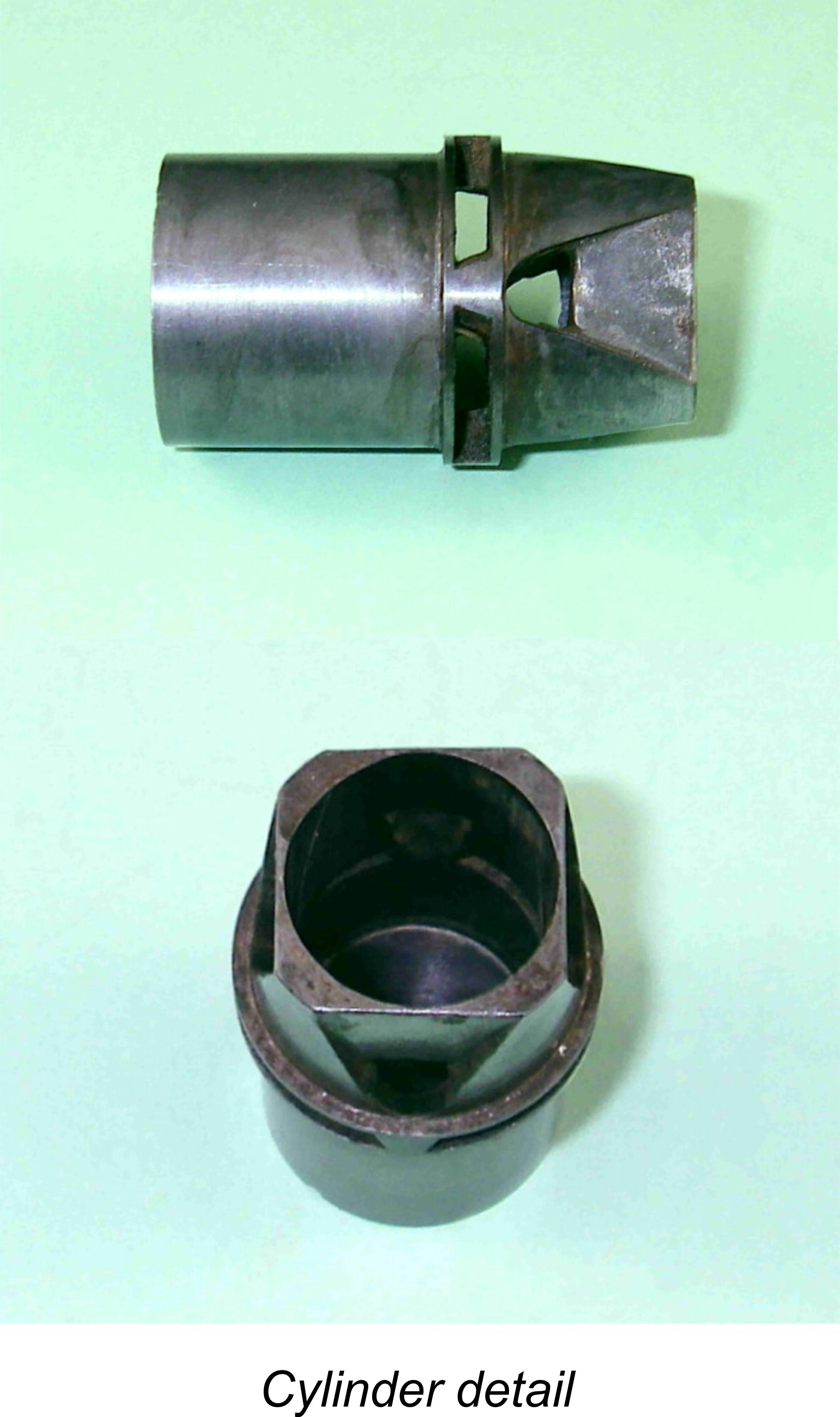
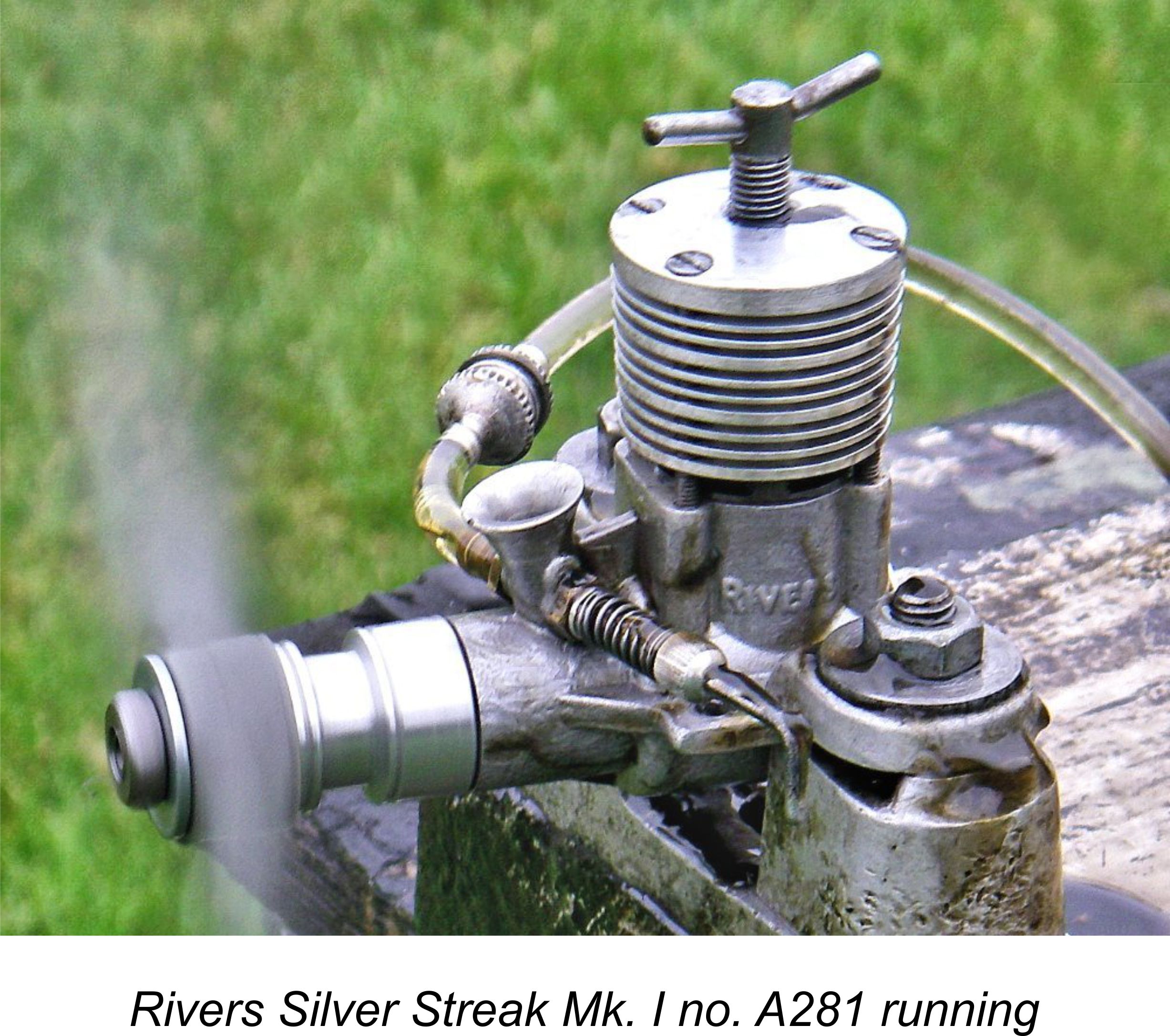
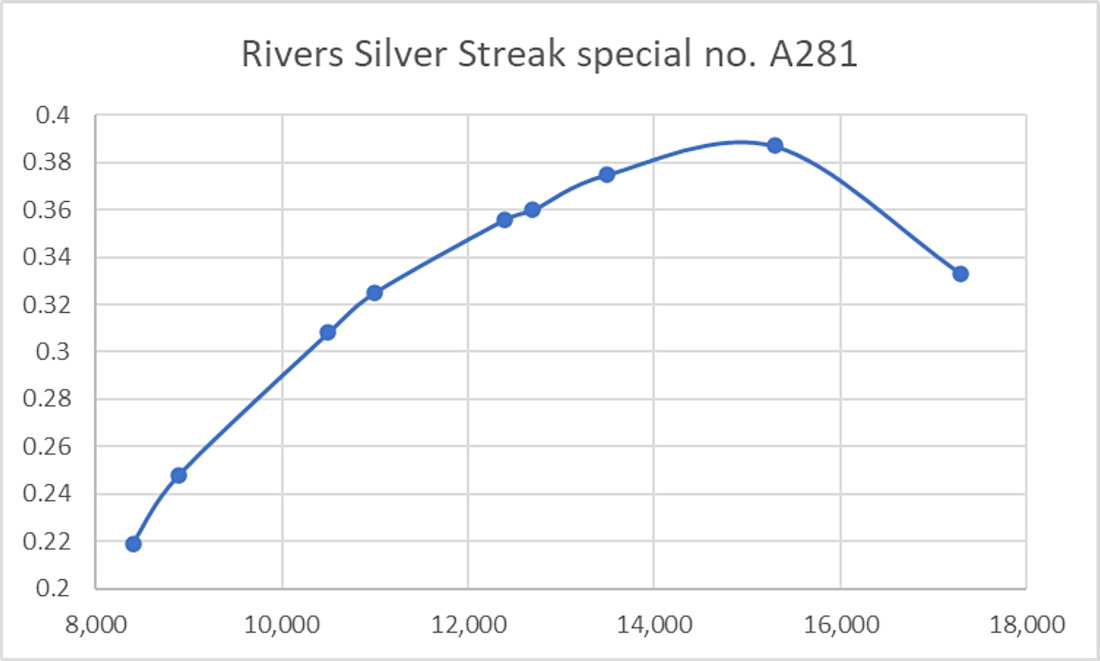
 Over five years after the original publication of this article, Alex Phin of
Over five years after the original publication of this article, Alex Phin of 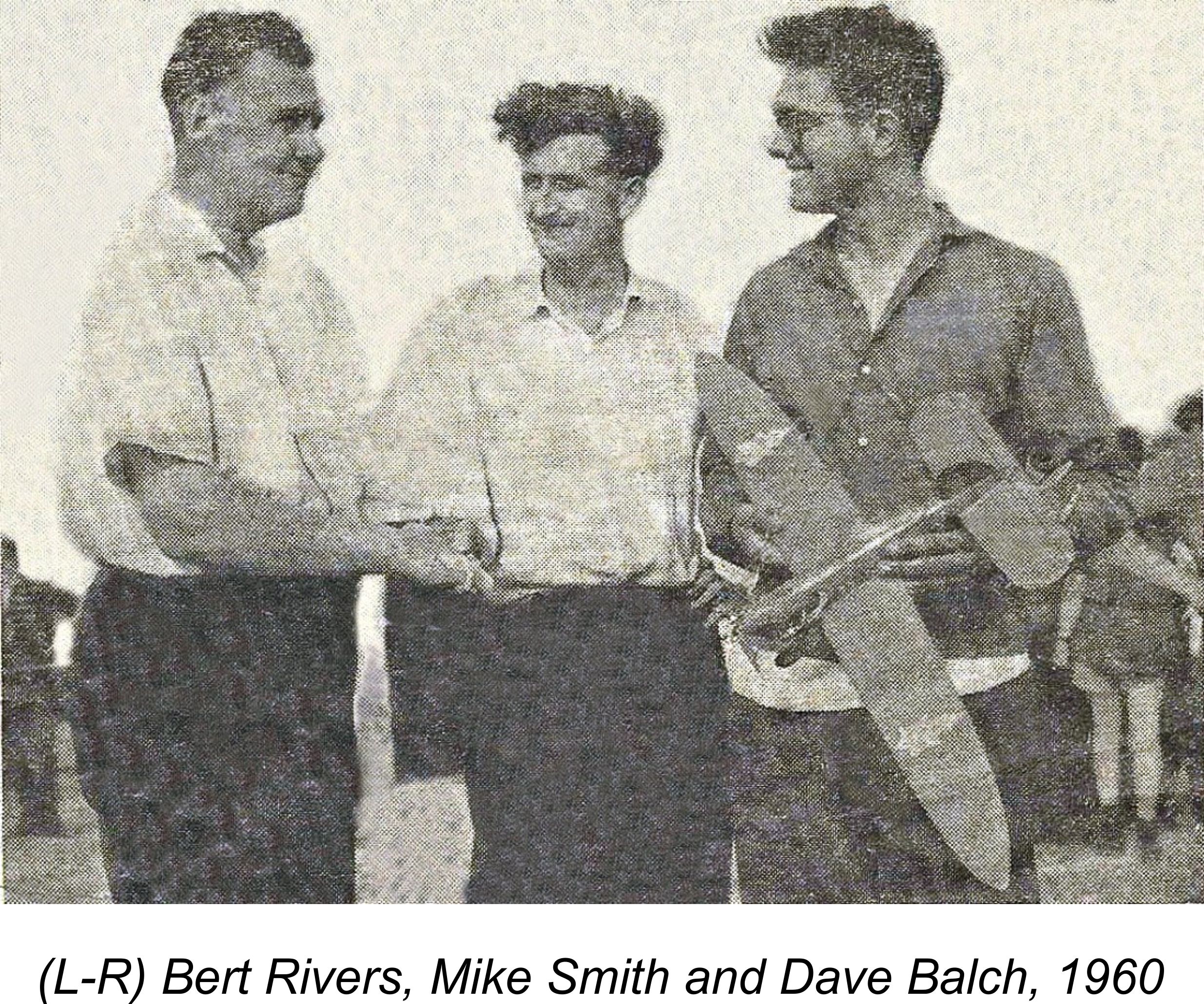
 "special" concocted by Rivers at the instigation of a customer who had definite ideas about improvements which he somehow persuaded them to incorporate into his own engine. Based on the relatively low serial number of A 281 (confirmed numbers for the Mk. I Silver Streak go up to at least TA 735), this must have happened relatively early on, certainly by mid to late 1959. Malcolm Ross's suggestion that Tom Pasco may have been the instigator is completely consistent with all of the above circumstances.
"special" concocted by Rivers at the instigation of a customer who had definite ideas about improvements which he somehow persuaded them to incorporate into his own engine. Based on the relatively low serial number of A 281 (confirmed numbers for the Mk. I Silver Streak go up to at least TA 735), this must have happened relatively early on, certainly by mid to late 1959. Malcolm Ross's suggestion that Tom Pasco may have been the instigator is completely consistent with all of the above circumstances.